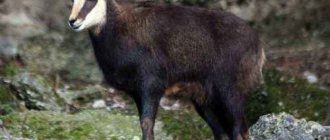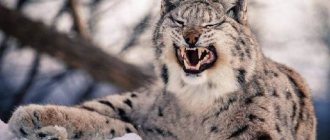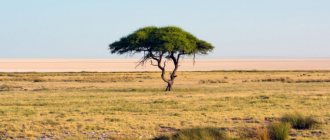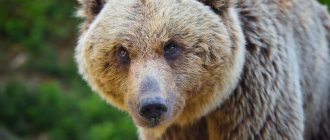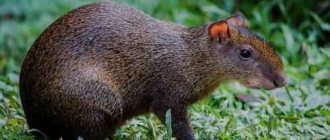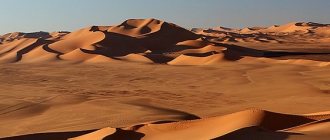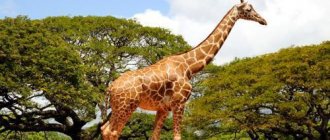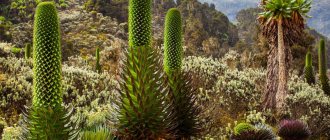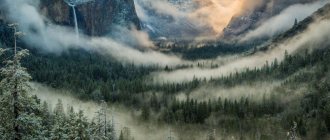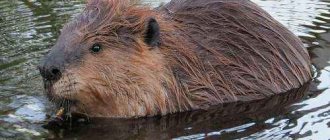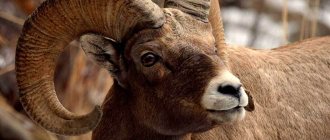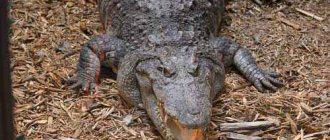Africa, the second largest continent (after Asia), covers approximately one-fifth of the planet's total land surface. The continent is bounded on the west by the Atlantic Ocean, on the north by the Mediterranean Sea, on the east by the Red Sea and the Indian Ocean, and on the south by the mixed waters of the Atlantic and Indian Oceans.
The total area of Africa is approximately 30,365,000 square kilometers and the length of the continent is about 8,000 km from north to south and about 7,400 km from east to west. In the northeast, Africa was connected to Asia by the Sinai Peninsula before the construction of the Suez Canal. Paradoxically, Africa's coastline, 30,500 km long, is shorter than Europe's because the sunny continent has few bays.
The solar continent can be described as a huge plateau, rising steeply from narrow coastal strips and consisting of ancient crystalline rocks. The plateau is higher in the southeast and slopes down towards the northeast. Usually, scientists conditionally divide the plateau into its southeastern part and its northwestern part. The northwestern region includes the famous Sahara Desert, the territory traditionally called the Maghreb by sailors, and two mountain systems - the Atlas and Ahaggar Mountains. The southeastern part of the plateau includes the Ethiopian Plateau and the East African Plateau.
Geography of Africa
Africa has a fairly wide range of climatic zones - equatorial climate, tropical climate with dry winters and rainy summers, monsoon climate, semiarid climate, desert climate and oceanic climate.
This rich geographical diversity has given rise to a great kingdom of living beings.
How did animals appear in Africa?
The very first traces of the formation of fauna in Africa date back to the early times of the existence of any life at all on our planet. But it is worth noting that the formation of nature in the form in which we see it now roughly dates back to the time of the splitting of the supercontinent Gondwana in the mid-Mesozoic era.
The formation of the fauna was largely due to various animal migrations between the ancient continents of Godwana - Madagascar, South America and, possibly, India. But the greatest flow went to and from Laurasia. In terms of the Godwana continents, migration was largely one-way, out of Africa, while exchanges with Laurasia were numerous and bidirectional, although mostly from Laurasia to Africa.
Gondwana supercontinent
The first exchange of Neogene fauna occurred in the Middle Miocene. The major exchange of terrestrial fauna between North Africa and Europe began around 6.1 Ma, approximately 0.4 Ma before the onset of the Messinian salinity peak.
During the beginning of the Tertiary period, Africa is covered with extensive evergreen forest, inhabited by endemic forest fauna with many species characteristic of southern Asia. During the Pliocene, the climate became dry and most of the forest was destroyed; forest animals found refuge on the remaining forested islands.
At the same time, a wide land bridge connected Africa to Asia and there was a large invasion of steppe fauna into Africa. At the beginning of the Pleistocene, a humid period began and most of the forest was restored, while the savannah fauna was fragmented and limited to small areas, as the forest fauna had previously been. The almost complete isolation of Africa from other regions has led to the close relationship of many species in different corners of the continent.
Mammals
Africa is home to 1,100 species of mammals. The sunny continent is home to a large number of rodents. It is home to 64 species of primates, the largest number of species of ungulates and bovids. This is a real animal kingdom, which for centuries has attracted adventure lovers from all over the world who want to compete with the power of nature itself.
a lion
African Lion
The lion is the “king of all beasts.” A huge feline, reaching a length of 208 centimeters and weighing up to 170 kilograms. Females are slightly less modest in size - up to 184 centimeters and 138 kilograms.
The lion is muscular, with a deep chest and a short, rounded head, reduced neck and round ears. Its fur varies in color from light brown to silver-gray, yellowish-red and dark brown. The colors of the lower parts are generally lighter. A newborn lion has dark spots that disappear when the cub reaches adulthood, although faint spots can often still be seen on the legs and lower parts of the body.
The lion is the only member of the cat family in which the males are significantly larger than the females. Males have wider heads and a noticeable mane that grows down and back, covering most of the head, neck, shoulders and chest. The mane is usually brownish with a hint of yellow, rusty and black hairs
Rhinoceros
Rhinoceros
Members of the rhinoceros family are among the largest remaining fauna, with all species reaching or exceeding one ton in weight. They are herbivores, have a rather small brain for their size (400–600 g), one or two horns and thick (1.5–5 cm) protective skin formed from layers of collagen consisting of a lattice structure.
They generally eat leaves, although their ability to ferment food in their intestines allows them to feed on more fibrous plant matter when needed. Unlike other odd-toed rhinoceroses, the two African rhinoceros species do not have teeth at the front of their mouths, instead relying on their lips to grasp food.
Rhinos are often targeted by poachers for their horns, which can be sold for big money on the black market. Some cultures widely used horns for medicinal purposes, as well as to create jewelry.
Giraffe
Giraffe
The giraffe is the tallest mammal on the planet. Giraffes once lived throughout the continent, but now their range has sharply decreased due to the activities of poachers and the destruction of their natural habitat. The long neck allows the animal to reach the freshest leaves; it lives in the arid savannas south of the Sahara.
Zebra
Savannah Zebra
Zebras are several species of African equine animals (the horse family), united by their characteristic black and white striped coat. Their stripes come in different types, the color of each individual is unique, like, for example, human fingerprints. They are generally social animals that live in small harems to large herds. Unlike their closest relatives, horses and donkeys, zebras have never been domesticated.
Interesting: Seas and oceans that wash Russia - list, map, description, photo and video
The unique stripes have become the hallmark of zebras, making them one of the most recognizable animal species. Striped horses live over a large area - from meadows and savannas to forests and mountains. Various anthropogenic factors have had a major impact on zebra populations, particularly hunting for pelts and habitat destruction.
Hippopotamus
Hippopotamus
The common hippopotamus, or hippopotamus, is a large, primarily herbivorous, semi-aquatic, artiodactyl and ungulate mammal native to sub-Saharan Africa. It is one of two extant species in the family Hippopotamidae, the other being the pygmy hippopotamus.
The name comes from the ancient Greek “river horse” (ἱπποπόταμος). After the elephant and rhinoceros, the common hippopotamus is the third largest species of land mammal and the heaviest extant artiodactyl. Despite their physical similarities to pigs and other land-dwelling ungulates, hippos' closest living relatives are cetaceans (whales, dolphins, porpoises, etc.), from which they evolved about 55 million years ago.
Interesting fact : hippos are the most dangerous animals in Africa. His size, incredible speed and strength become a serious threat to those who enter his territory.
Chimpanzee
Chimpanzee with a tool
There are two species of chimpanzee - the common chimpanzee and the bonobo. The chimpanzee is covered in coarse black hair, but has a bare face, fingers, toes, palms of the hands and soles of the feet. The common chimpanzee is larger and stronger than the bonobo, reaching a weight of 60 kilograms. The chimpanzee's gestation period is 8 months, and the baby is weaned at 8 months, but the baby's close relationship with its mother will continue for several more years. They usually live in groups of 15 to 150 individuals. There is a rigid hierarchy of males in groups, but disputes are usually resolved without the use of physical violence.
Chimpanzees are the closest relative to humans - 98% of their genes are the same!
Interesting fact : All groups of chimpanzees that have ever been studied by scientists used available objects for their own benefit - sticks, stones, grass, leaves - and thoughtfully used them in the hunting process.
Birds
More than 2,600 species of birds live in Africa (permanently or temporarily), 1,500 of them belong to the order Passeriformes. 114 African bird species are at risk of extinction. The great wealth of the bird kingdom is one of the calling cards of the continent: Africa offers you to listen to countless species of songbirds, enjoy the sight of colorful parrots, and here you can even look at penguins!
African white-crested kalao
African White-crested Kalao
The White-crested Kalao is a species of hornbill, distinguished by its white tail, neck and chest. They live in the humid forests of Central and Western Africa.
The size of an average individual usually varies from 83 to 102 centimeters, and its weight is approximately one and a half kilograms. Females, in turn, are smaller than males.
African brilliant teal
African Splendid Teal
The African Splendid Teal is an African species of duck that is native to sub-Saharan Africa. It is the smallest species of Anatidae in Africa and one of the smallest in the world.
Although the glossy teal's beak is more like a goose's, they are still closely related to ducks. The weight of these ducks reaches only 285 grams with a wingspan of 165 millimeters. The beak continues to the forehead, so in appearance they resemble geese. Shiny teals feed mainly on water lily seeds and other seeds floating on the surface of water bodies, as well as insects. They have strong family ties, so one pair of ducks can be seen together year after year. In captivity it is almost impossible to achieve reproduction.
African vulture
African Vulture
The African Vulture, also known as the Griffon Vulture, has downy feathers on its neck and head. The bird is of impressive size - body weight varies from 4 to 7 kilograms, and the wingspan of some representatives of the species reaches 2.25 meters. Like other vultures, the African vulture is a scavenger. The vulture nests in trees in savannas in Western, Eastern and Southern Africa. They lay one egg at a time.
Interesting fact : vultures are the main “consumers” of Africa. It has been estimated that only 36% of the total mass of dead animals goes to terrestrial predators - the majority are eaten by voracious vultures.
African penguin
African penguin
The African penguin or spectacled penguin, like all other members of the family, cannot fly. They are small in size - adult individuals reach only 70 centimeters and weigh up to 5 kilograms. The color is black on the back and white on the front.
The African penguin is a skilled hunter, using its excellent swimming skills to hunt fish, which form the bird's main diet. Penguins attract many tourists every year.
Wavy Astrild
Wavy Astrild
The Wavy Astrild is a small bird, a member of the passerine family, belonging to the finches family. The bird has a wide habitat - south of the Sahara it can be found almost everywhere.
Astrild does not grow more than 13 centimeters and weighs on average 10 grams. It has a slender body with short, rounded wings and a long tail. The plumage is mostly gray-brown, with small streaks of dark brown. A red stripe runs through the eyes, and the cheeks and throat are whitish. Females are similar to males, but are paler and have less red on their bellies.
Common social weaver
Common Social Weaver
This is a small bird, growing up to 14 centimeters, weighing a maximum of 32 grams. It has a black chin, black stripes on the sides and a back with black speckles. It is impossible to determine gender by color.
They live in the savannas of South Africa. Birds are social - they live in large communal nests. This kind of behavior is rarely seen among birds. Their nests are real masterpieces of architecture in nature.
Variable tropical rainforests
They are characterized by high humidity during the rainy season and severe drought. Vegetation is capable of shedding leaves during drought. During the rainfall season, they resemble equatorial forests with an abundance of vines. There are also far fewer species here than in wet and hardwood forests.
The tsetse fly lives in the forests and tropics of Africa - the most dangerous insect that can infect humans with a virus that causes unbearable pain and fever.
Variable-moist forests are located next to savannas and often intersect with them by animal species. Tropical birds, monkeys of various species, and wild cats also live here. Ferrolitic soils of brown-yellow color predominate, on which bananas, ficus, and coffee grow well.
Fish
Africa is home to the richest diversity of freshwater fish in the world , with more than 3,000 species. The East African Great Lakes - Victoria, Malawi and Tanganyika - are a center of biological diversity for many fish species, especially cichlids (more than two-thirds of a family of more than 2,000 species live here). The West African Coastal Rivers region covers only a small part of West Africa, but it is home to 322 species, 247 of which are found only here, and 129 of which live in small patches of this area. The rivers of the central part of the continent are inhabited by 194 species of fish. If we talk about marine fish, the Indian coast has the richest diversity - about 2,000 species.
Protopter
Protopter
Protopter are elongated, eel-like fish with thread-like pectoral and pelvic fins. They have soft scales, and the dorsal and caudal fins are fused into a single structure. They can either swim like eels or crawl along the bottom using their pectoral and pelvic fins. The largest individuals reach about 200 cm in length.
These fish live in shallow waters. Protoptera are lungfishes, which allows them to survive without water for many months in burrows made of hardened mud under a dry stream. Younger fish prefer to use their gills for breathing, obtaining 90 percent of their oxygen this way, but mature fish use their lungs more often, leaving only 2 percent of their oxygen for the gills.
Big tiger fish
Great tiger fish
This is a very large species of freshwater predatory fish. You can find tiger fish in the Congo River basin and Lake Taganika. The species has large teeth, the body can reach 1.5 meters in length and weigh up to 50 kilograms.
Interesting: Giraffe
